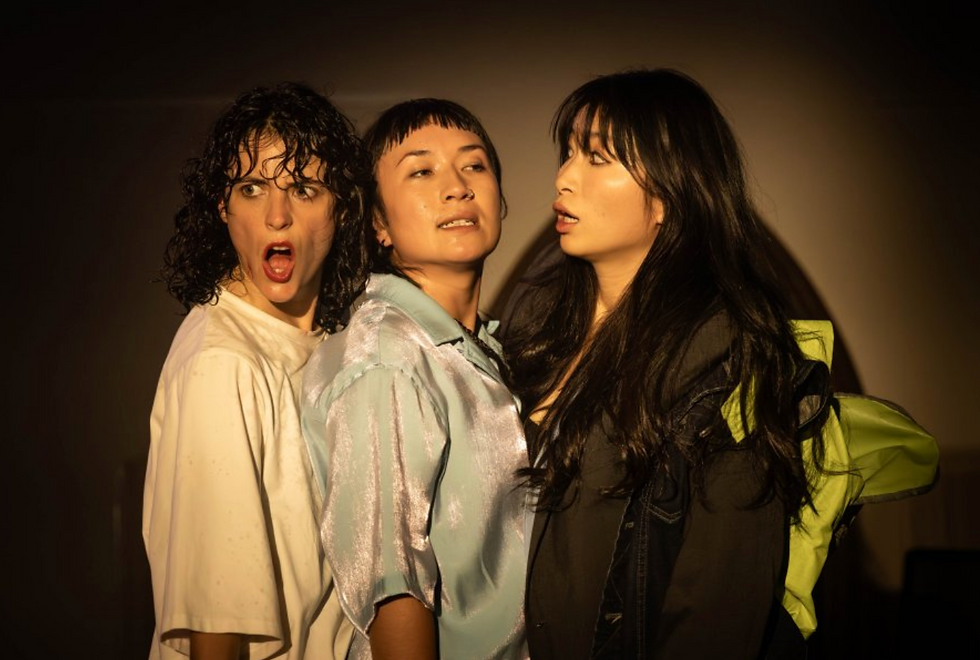Review: Homo Pentecostus at Malthouse
- Theatre Travels

- May 16, 2024
- 2 min read
Reviewed by Lucy Lucas
Co-created by Joel Bray, Emma Valente and Peter Paltos, Homo Pentecostus, is a riotous post-modern exploration of transcendence and queer euphoria against the backdrop of the 1990s Australian Pentecostal movement.
The Malthouse has had some hits and misses in the dramaturgy department over the past couple of years, with much of its output feeling less and less connected to the reality of the world around it (the recent Hour of the Wolf being a particularly stark example of this). However, Homo Pentecostus is a welcome and refreshing reprieve.
The night takes the form of a series of conversations between ex-Pentecostal devotee Bray and the enduringly faithful Paltos broken up with non-textual vignettes. Chronology takes a backseat to the tangible and visceral here – alongside the spoken, anecdotal experiences of Bray and Paltos we are repeatedly exposed to the sensations of shame, desire, ecstasy and doubt that accompany those experiences. The two men expertly walk the line between autobiography and imagination, we understand these are their stories but there is enough theatrical power employed that it never feels like a Ted talk. Bray’s phenomenal movement instincts combine beautifully with Kate Davis (set), Katie Sfetkidis (lighting) and Marco Cher-Gibard’s (sound) design work to craft breath-taking theatrical imagery from start to finish.
The work is so full of revelatory thinking and spectacular theatrical images that it is impossible to capture them all here. The creators expose and tangle with a huge range of connections and contradictions including the inextricable links between spiritual and sexual yearning, between Pentecostal/biblical/occult imagery and queer aesthetics and between religious and personal rituals. There is a joyful and profound celebration of mothers as the original divas in many queer men’s lives whilst simultaneously acknowledging their role in the ongoing repression of their children’s freedom within these communities. Additionally, the positioning of Paltos as an ongoing believer forces the work to ground itself in respect. It can’t stray into caricature of the religious and this is its strength. There will always be inherent conflicts between the repressiveness of organised religion and individuals’ spiritual journey. The artists’ familial experiences further complicate this dynamic by introducing the challenge of inherited historical and cultural weight. For both Paltos and Bray, as descendants of persecuted minorities and the survivors of attempted genocides, culture and religion are not simply about their personal spiritual journeys but about an assumed responsibility to one’s ancestors and community.
Far from being a period piece Homo Pentecostus sizzles with complexity and bitingly relevant satire. Pentecostalism is the fastest growing religious identity in Australia and with one of our most recent Prime Ministers a dedicated adherent, its growing power and influence cannot be understated. It is impressive therefore that Homo Pentecostus, even whilst laying bare the dangers inherent in the church, is able to remain a perfect balance of queer joy and trauma. Bray and Paltos are able to expose the horrors of conversion therapy whilst having realistically nuanced and whole discussions of religion and the spiritual. I know for some this style of theatre making feels unfinished, but I personally admired the bravery of positing more questions than can be answered within an hour.
A riveting and masterful work, Homo Pentecostus is not to be missed.

Image Credit: Gianna Rizzo




